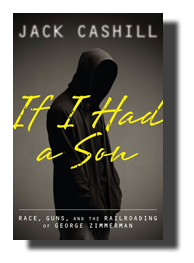What Happened to
George Zimmerman
Order your copy of Jack Cashill's
"If I Had a Son"
November 20 , 2013 - WND.com
© Jack Cashill
“ We had to march to even get a trial,” said Al Sharpton in one of his rare moments of truth.
Sharpton was speaking of the pressure he and his recklessly corrupt media allies brought to bear on the State of Florida to try George Zimmerman for the February 2012 shooting death of Trayvon Martin.
Sharpton’s angry mobs had their effect. To ease the pressure, the City of Sanford and the State of Florida started sacrificing their own.
On March 21, more than three weeks after the shooting, the Sanford City Commission stoked the bonfire by voting “no-confidence” in police chief Bill Lee.
Lee had angered the mob by telling them, “Until we can establish probable cause to dispute that we don't have the grounds to arrest [Zimmerman]."
As Lee would later tell CNN, Sanford’s black city manager, Norton Bonaparte, asked Lee “several times” during that period, “Can an arrest be made now?”
“It was related to me that they just wanted an arrest,” said Lee. “They didn’t care if it was dismissed later.“ Lee did not specify who the “they” was, but Sharpton and the Martin family attorneys had to be among them.
Lee’s resistance cost him his job. Bonaparte eventually fired him. The lead investigator, who also resisted the mob, was demoted.
In the spirit of weak-kneed governors from Pontius Pilate to the present, Florida’s Republican Governor Rick Scott was prepared to sacrifice the transparently innocent Zimmerman to appease the mob.
It was just an arrest after all. Zimmerman would get a fair trial. True, sixteen months of media defamation, house arrest, and relentless death threats might cause a little emotional scarring, but at least the mob would be held at bay.
The day after the governor intervened, the president did. Although Zimmerman lobbied for Barack Obama and voted for Obama at least once, in the final analysis he did not look enough like Obama to be his son, and so the president sided openly with the Martin family.
The opportunity to align oneself with the remnants of the civil rights movement has left many a Republican giddy. State Attorney Angela Corey was no exception.
If her numbers reflected local norms, the great majority of the defendants she convicted in murder cases were black or Hispanic.
Like the prosecutor Kramer in the Tom Wolfe classic, Bonfire of the Vanities, she too must have thought “this eternal prosecution of blacks and Latins” not immoral exactly, but in “bad taste.”
Now, however, she had a shot at what Wolfe called his central character, Sherman McCoy, a “much-prized, ever-elusive . . . very nearly mythical creature, the Great White Defendant.”
Zimmerman may not have been exactly white, but he was white enough for Angela Corey, who was now finally on the side of the “precious victims”—in this case, six-foot, would-be knock-out king, Trayvon Martin.
Although his mother was Peruvian and Spanish was his first language, Zimmerman was too white for the Hispanic “rights” organizations like La Raza (“The Race”) whose president condemned Chief Lee’s “grievous failure of justice” in not arresting Zimmerman immediately.
“His background is not clear,” said Hispanic activist Robert Lovato of Zimmerman. “Is he Latino? Is he white? Is he both? Who knows? It’s irrelevant. What’s relevant are his actions, his racist comments, and his cold-blooded killing of an innocent young man.”
Between the time of his arrest and his trial, the innocent Zimmerman nonetheless faced a societal wrath somewhere on the scale between that of O.J. Simpson and Lee Harvey Oswald.
Before Zimmerman was bonded, his jailers recorded his phone calls. “Whoever picks me up can just go straight into the garage and go into the hotel through there,” George told his wife Shellie.
Shellie added a wrinkle, “Or transfer you into a different car. Have, like my car waiting, in the garage.” They were not being paranoid. There was a bounty on George’s head.
In spite of his very real anxiety, Zimmerman never forgot to tell Shellie how much he loved her. On April 15, for instance, he recounted a “nice” dream he had in which he bought her a scarf for her birthday.
“Oh, you’re so cute,” gushed Shellie. “I love you so much.” Said George, “I love you so much.”
Between April 2012 and July 2013, Zimmerman’s life fell apart. He showed up at the trial dead-eyed, grossly overweight, and financially and emotionally bankrupt.
The local NAACP, with which he had worked on a civil rights case a year earlier, had betrayed him. The State of Florida had sacrificed him to the mob.
His president denied him. The media had rendered the mid-Florida ether so poisonous he could scarcely leave the house. His wife no longer loved him and was eager to tell the world about it.
Zimmerman’s acquittal settled nothing. The death threats amplified. The attorney general continued to hound him despite full clearance by the FBI more than a year prior. And the media cried “Injustice!”
“I still see sadness in his eyes,” said his brother Robert soon after the acquittal. “He was definitely not the same person I had seen a few days before the incident.”
In the last two years, Zimmerman has experienced more betrayal on more levels than most of us will in a lifetime.
Now, it appears that his latest “victim,” girlfriend Samantha Scheibe, was soliciting national media interviews weeks before their well-publicized dust-up. http://bit.ly/1hWtuub
Regardless of the circumstances, each misstep Zimmerman has made post-trial has left the media giddy. They seem to think it vindicates their utterly subversive rush to judgment.
The fact is that the Zimmerman they now happily trash is the Zimmerman they helped create. Whatever happens going forward, the blood is on their hands.


